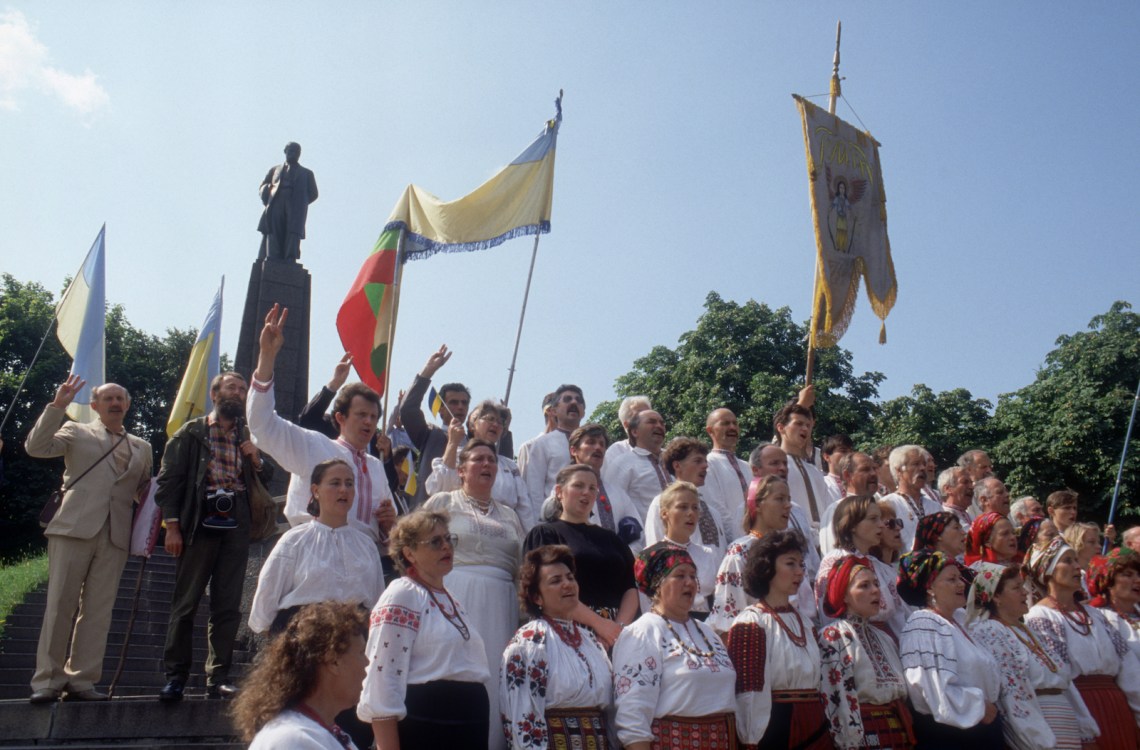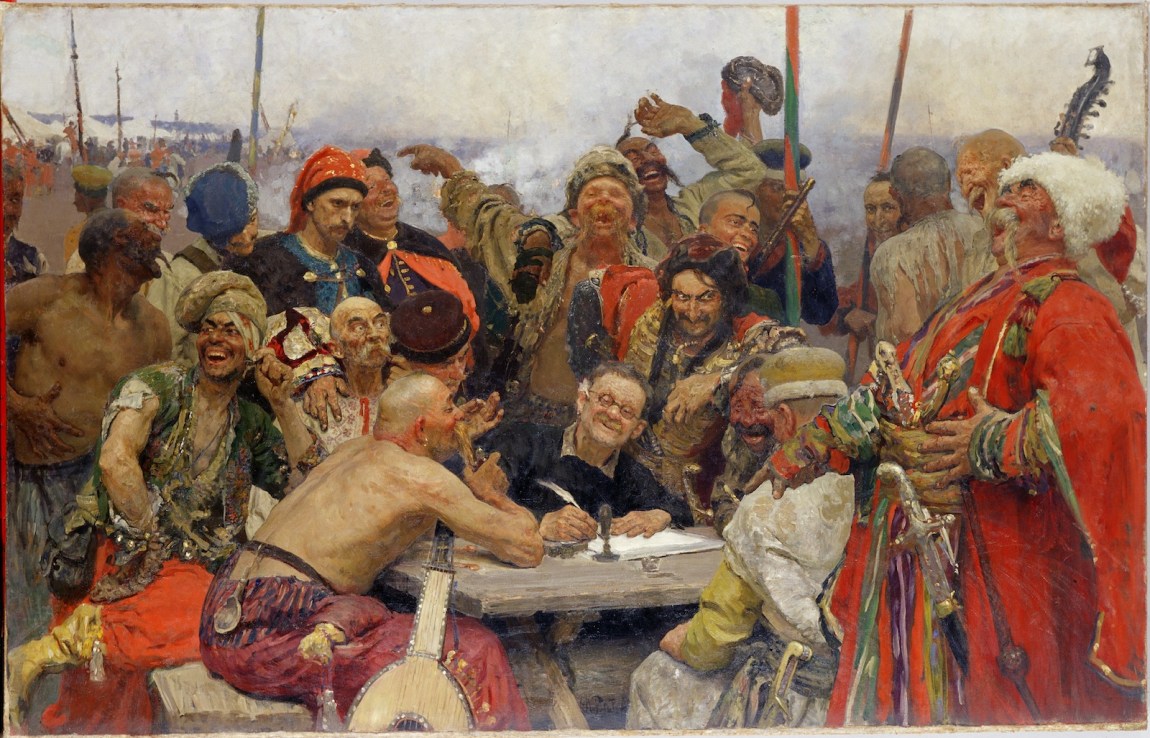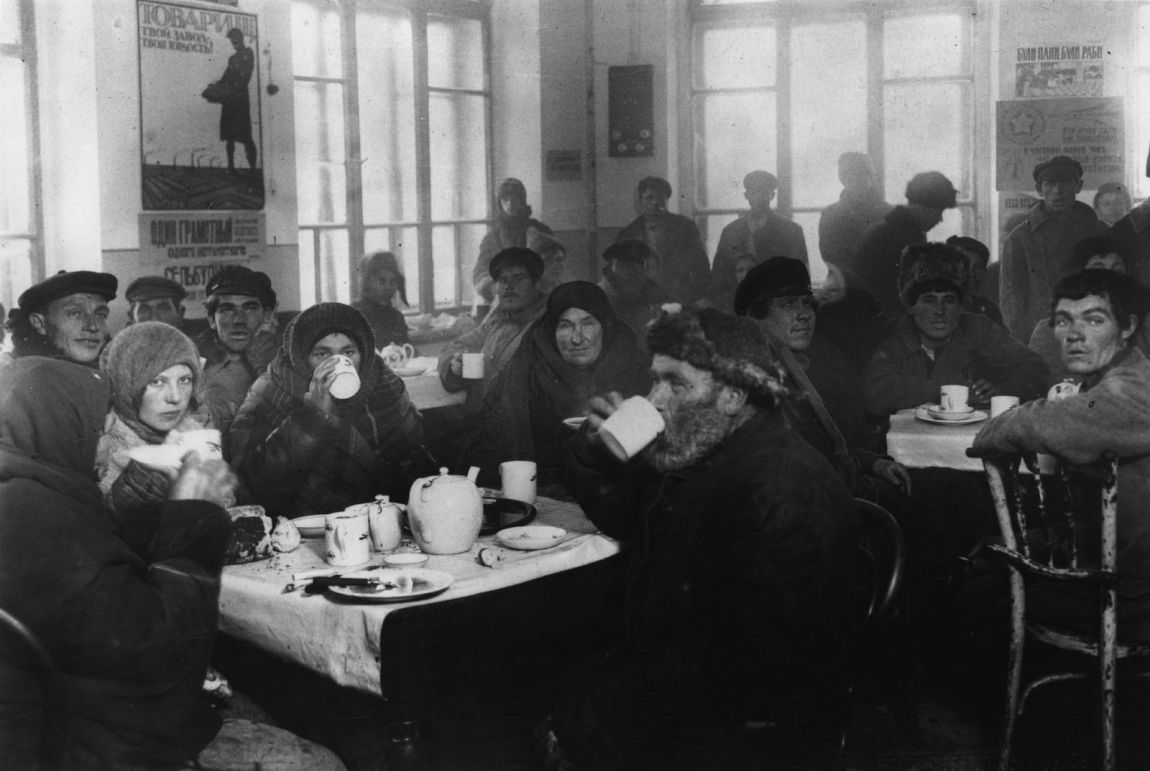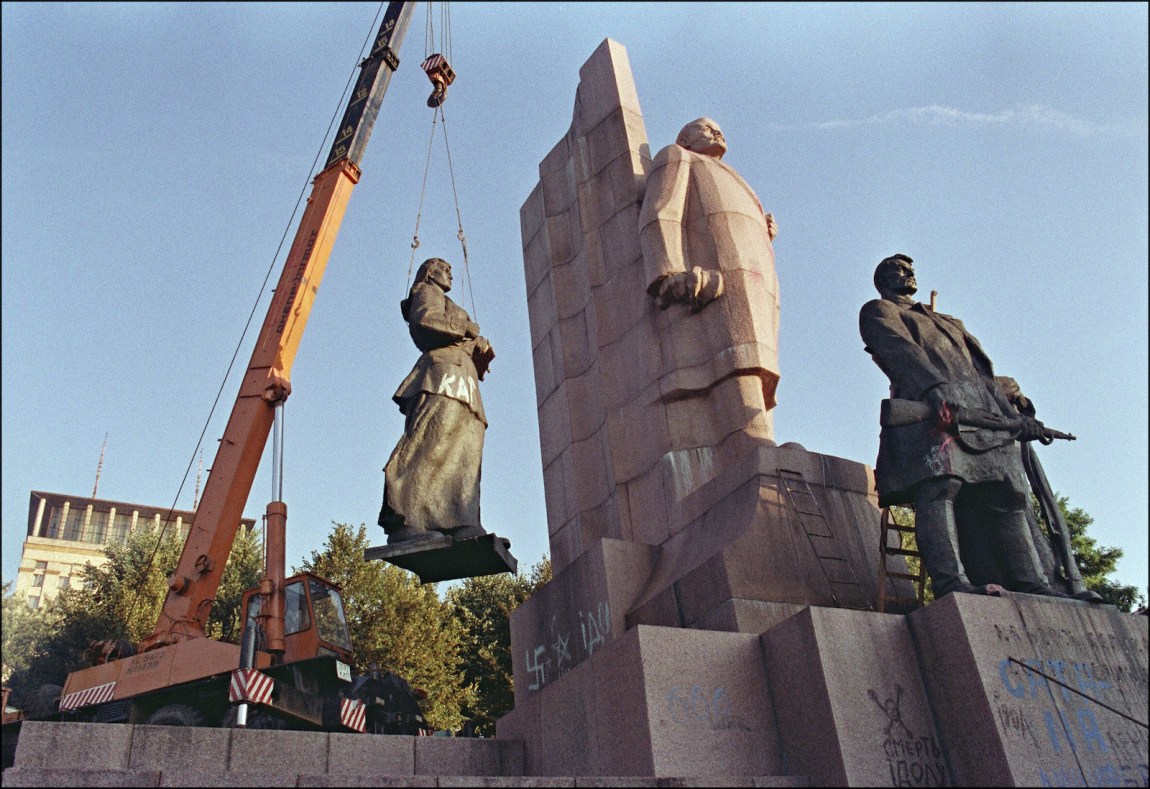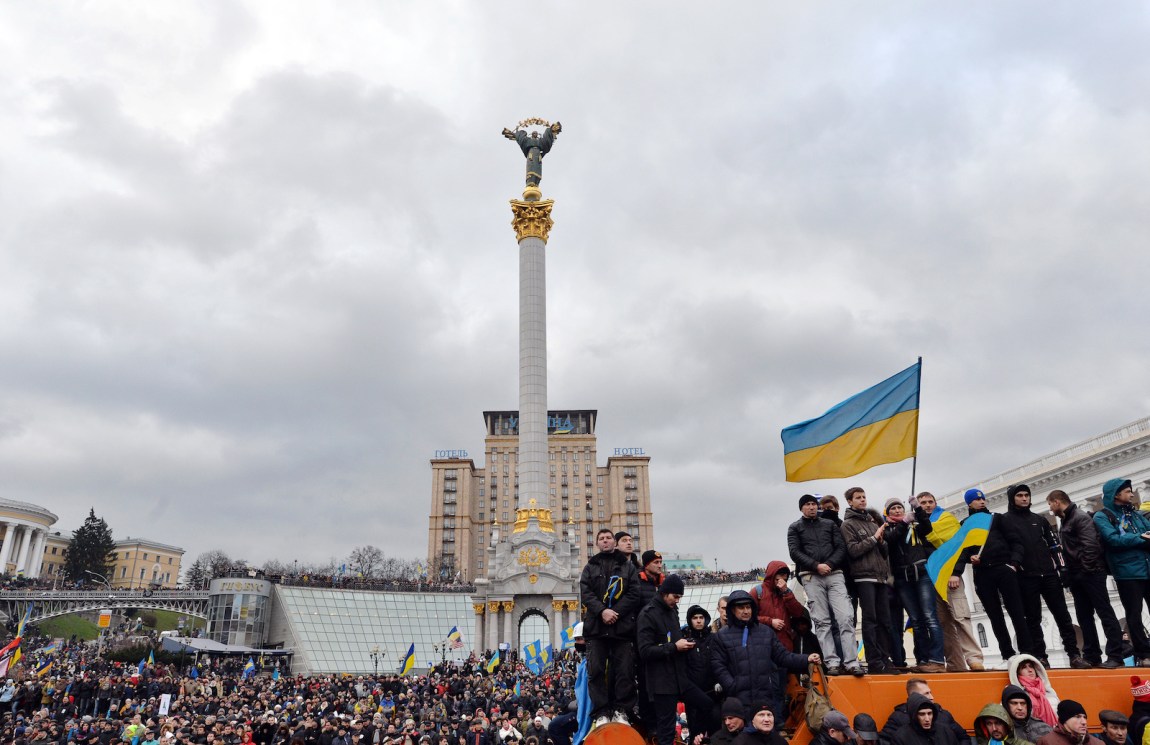The Soviet Union’s demise in 1991 took everyone by surprise, including the man most directly responsible for it. In 1985 Mikhail Gorbachev had launched perestroika (“reconstruction”), a reform program aimed at radically restructuring Soviet society. A crucial aspect of this initiative, glasnost, promised that the party-state’s work would from then on be “transparent.” In other words, Communist officials could be criticized openly. Among the many unexpected consequences of these reforms was the emergence of new civil-political organizations that broke the Communist Party’s monopoly on public space.
In the Soviet Union’s satellites in Eastern Europe, perestroika emboldened domestic opposition movements that helped launch the series of “gentle” revolutions, such as Solidarity in Poland and the Velvet Revolution in Czechoslovakia, that brought down Communist regimes in 1989. But the reforms, as the historian Mark Kramer has shown, also encouraged resistance within the Soviet Union itself, including the popular fronts in the Baltics and the nationalist movement in Georgia that called for independence.
Ukraine, the Soviet Union’s second-largest republic, lacked a unified national opposition. Yet on December 1, 1991, more than 90 percent of Ukrainians voted in support of independence. Boris Yeltsin, who had been elected president of Russia in June, had assumed that even if the USSR dissolved, Ukraine would remain attached to Russia. When a Ukrainian journalist criticized his reluctance to let go of the republic, the Kremlin press secretary snapped: “You don’t want to live with Russia in a Union? This is a Communist legacy for you? Then go, but return Crimea and Donbas to us!”
To justify his war of aggression against Ukraine, now in its ninth month, Vladimir Putin has deployed the same rhetoric Yeltsin and his associates used then to argue that Ukraine was an invention of the Soviet Union, unimaginable outside of Russia. Like all powerful propaganda, the claim rests on a grain of truth: post-Soviet Ukraine was in many respects a product of decades of Soviet rule. From the Soviets, Ukraine inherited a state apparatus and institutional structures spanning territories that prior to being incorporated into the Ukrainian Soviet Socialist Republic (SSR) after World War II had been under different administrations, including at various points those of Poland–Lithuania, Austria, and tsarist Russia. The Soviets brought into being both an expansive state—as much Soviet as it was Ukrainian—and a Ukrainian identity that reflected the newly urban, multiethnic, and bilingual character of Soviet Ukraine’s population. That identity was no longer defined in opposition to Russia, as it had been in the age of Romantic nationalism. Russia was seen as a friendly older sibling, further along down the path to Communism.
For two hundred years Ukrainians have responded to their shifting circumstances by creating narratives about their national past. Over the course of the twentieth century they declared their independence five times: in 1918 in Lviv and Kyiv, in Transcarpathia in 1939, again in Lviv in 1941, and in Kyiv in 1991. Each time, they needed not only to recreate a Ukrainian state but also to redefine a Ukrainian nation. What that nation should look like was by no means self-evident. Nineteenth-century Ukrainian nationalists, for instance, had disagreed about what made Ukrainians distinctive and whether Poles or Russians posed a greater threat to Ukrainian identity. Among Galician Ruthenians alone, there were no fewer than five different orientations: Polonophile, Ukrainophile, Russophile, Old Ruthenian, and Little Russian. During World War II some Ukrainians put their faith in Nazi Germany, while others reckoned their chances of achieving some form of statehood would be higher under Soviet rule. New divisions surfaced after 1991 between Eastern Ukrainians, who remained attached to post-Soviet Russia, and Western Ukrainians, who looked to the West rather than to Moscow. The Russo-Ukrainian war is the latest bloody stage both in the Soviet empire’s unfinished collapse and in this long history of Ukrainian nationalism.
*
The Ruthenian language, as Ukrainian was referred to at the time, became differentiated from Russian and Belorussian between the thirteenth and fourteenth centuries, when most of its speakers lived in the territories of the former medieval state of Kyivan Rus’. After falling prey to the Mongols, the various territories formerly belonging to Kyivan Rus’, now divided between different principalities, were ruled by the Golden Horde, Muscovy, Hungary, the Ottoman Empire, and Poland–Lithuania. By the seventeenth century a separate Ruthenian identity was emerging, though there was no Ruthenian or Ukrainian nation to speak of yet. In lands where Ruthenian was spoken, Andrew Wilson writes in his study The Ukrainians: Unexpected Nation, elites switched frequently between it and Polish, Latin, and Church Slavonic.1 Education, conducted mainly in Polish, provided noblemen of Ruthenian origins with an avenue for assimilation into the Polish nation—a nation of nobles.
Before the late sixteenth century, most Ruthenians in the Polish–Lithuanian Commonwealth belonged to the Orthodox faith. A separate Greek Catholic or Uniate Ukrainian Church, directly subordinated to the pope, was formed at the Union of Brest in 1596. Orthodox Cossacks and peasants resisted the Union, most famously in 1648, when the Cossack leader (Hetman) Bohdan Khmelnytskyi led a rebellion against Polish rule. In the treaty of Pereiaslav in 1654 Khmelnytskyi pledged allegiance to the tsar, bringing Ukrainian territories under temporary Russian control. Later, the treaty—which Russophile narratives redefined as a merger or the “reunification of Rus’”—was invoked to justify Russia’s claims to Ukraine. Ukrainian nationalist historians, by contrast, defined the treaty as an act of voluntary union whereby the Cossack hetmanate had sought Russian protection without ever renouncing its autonomy.2
Advertisement
After the partitions of Poland in the eighteenth century, Ukrainian lands under Polish rule were divided once more, this time between Russia in the east and Austria in the west. Under both Austrian and Russian rule, Ukrainian nationalism developed in tandem with Polish nationalism. When the inhabitants of Congress Poland, a territory Russia had acquired from Napoleon, revolted in 1830–1831, tsarist officials clamped down on the insurrection and sought to counteract the influence of Polish nationalists by promoting a tripartite Russian nationality that included Russians, Belorussians (“White Russians”), and Ukrainians (“Little Russians”).
To encourage the development of this shared “Rus” identity among Ukrainian elites, tsarist officials opened new universities in Kyiv and Kharkiv. But rather than centers of Russophile culture, as the officials had hoped for, the universities became hotbeds of Ukrainian nationalism. In Kyiv they were home to a clandestine society, the Brotherhood of Saints Cyril and Methodius, whose members viewed Ukrainians as a distinct nationality defined by antagonism with both Poland and Russia. The Brotherhood’s most illustrious member was the poet and artist Taras Shevchenko. A former serf, Shevchenko published a collection of ballads in St. Petersburg in 1840 entitled Kobzar, which laid the foundation for a new vernacular Ukrainian literature. Mykola Kostomarov, another member of the Brotherhood, called for a larger, Ukrainian-led Slavic confederation built on egalitarian principles and popular representation in his manifesto The Books of Genesis of the Ukrainian People. Both men, Wilson argues, defined the Ukrainian nation as inherently democratic, fundamentally different from Russia in its “love of liberty for one’s own against the imperialist’s desire to rule all others in chains.” In 1847, tsarist officials arrested Kostomarov and Shevchenko and dismissed the Brotherhood as an instrument of Polish intrigue. When the Poles revolted again in 1863, tsarist officials banned all Ukrainian publications and proclaimed the Ukrainian language a Polish invention.
In Austria, a Ukrainian nationalist movement took off after 1848, when Ukrainians in Galicia and the neighboring province of Bukovina organized themselves politically for the first time in the Ruthenian Supreme Council. During the preceding decades, Austrian officials had backed Ruthenian claims against Polish revolutionary aspirations and encouraged Ruthenians to develop an identity of their own through cultural institutions such as the theological seminary for Greek Catholic Ruthenians in Lviv (Lemberg at the time). Now, however, the Hapsburg monarchy made a tacit compromise with the Poles, allowing them to become the dominant force in Galicia in return for their loyalty. Disappointed, the Ruthenian intelligentsia in Austrian-ruled Galicia looked to Russia for protection and embraced the “Little Russian” identity that tsarist officials promoted as part of their anti-Polish campaign. This Russophile mood prevailed among Austrian Ukrainians until the 1880s, when the Austrian empire clamped down on Russophile Ukrainians in a series of trials. A Ukrainophile current, backed by the Austrian administration and populist in orientation, took over later.
World War I opened up a plethora of new possibilities for Ukrainian nationalists by simultaneously bringing both the tsarist and Austro-Hungarian empires to an end. It did so under deeply unstable conditions. Between 1917 and 1919, regions in present-day Ukraine passed through no fewer than six different governments in succession: the independent Ukrainian National Republic (UNR) established in 1917; a Bolshevik-controlled Ukrainian People’s Republic proclaimed in November 1917 in the east; a month-long restoration of the UNR in 1918; a German-controlled puppet government; yet another iteration of the UNR under a committee called the Directorate; and another independent state in the formerly Austrian territories, the West Ukrainian National Republic (ZUNR), which unified with the Directorate in 1919. Over the course of the next year, multiple armies—the Bolsheviks, the Whites, the Polish army, Entente troops, and anarchist forces—crossed the territories of this hybrid Ukrainian Republic. In a bloody civil war, the Republic lost some of its lands to Poland, others to Romania, and yet others to the Bolsheviks. Scattered across several empires, Ukrainian speakers would not be reunited under one state for more than two decades.
*
Uniting them would be a Soviet project. After winning the civil war in Russia and regaining most of its former tsarist empire, the Bolsheviks proceeded to reorganize the territories over which they ruled into a new kind of state. What exactly this state would look like was uncertain, but it would need to tame non-Russian nationalisms, in particular the Ukrainian national movement, one of the most prominent and well-organized in the former empire. In his writings about Ukraine, Lenin developed his approach to the “nationality problem,” based on the idea that nationalism was an inevitable stage on the way to communism. The new Bolshevik state, as Lenin envisioned it, was therefore to incorporate national identities into its structures.
Advertisement
Ukrainians, for their part, had been forging a national identity since the mid-nineteenth century. While most of the peasant population still did not think of themselves as an ethnic group, Ukrainian elites had a literature of their own dating back to Ivan Kotliarevsky’s Eneida, a travesty of Virgil’s Aeneid published in 1798 with Zaporozhian Cossacks in leading roles. “Not long ago it was still being said that the Ukrainian republic and the Ukrainian nation had been thought up by the Germans,” Stalin, then commissar of nationalities, said in 1921. “Yet it is clear that the Ukrainian nation exists and that the development of its culture is a communist responsibility.”
The Ukrainian Soviet Socialist Republic thus became one of the main constituent, quasi-sovereign republics of the USSR when it was formally established on December 30, 1922. In practice, the USSR was an empire ruled from Moscow, but one that defined itself in anti-imperial terms. Its commitment to anti-imperialism was a hard sell for the non-Russian nationalities, particularly Ukrainians, many of whom saw the Russian-speaking Bolsheviks as inheritors of an older imperial tradition that had suppressed Ukrainian culture. Lenin believed he could overcome these suspicions by recruiting more non-Russians into the Communist Party and Soviet state structures. This idea was at the heart of korenizatsiia, a “nativization” campaign that saw local Ukrainians promoted to important positions in the party-state and the Ukrainian language become dominant in public institutions. Nearly every schoolchild in the Ukrainian SSR was studying in Ukrainian by the end of the 1920s.3
By cultivating loyalty among Ukrainian-speaking cadres, Soviet officials were also hoping to tighten their grip on the peasantry, which had remained more interested in land than in national self-determination, anti-imperialism, or communism. Between 1918 and 1920, as a deadly civil war between the Whites, Reds, and Greens (local peasant militias who opposed both Whites and Reds) was sweeping Ukraine, armed peasant revolts shook the countryside. The anarchist revolutionary peasant leader Nestor Makhno fought seemingly everyone: the UNR, the Central Powers, the White Army, and the Red Army. None of these forces succeeded in harnessing peasant unrest.
The korenizatsiia policies the Bolsheviks introduced in Ukraine were strikingly progressive, especially when compared to the aggressive antiminority policies that Poland and Romania were pursuing at the time, but they were short-lived. In the 1930s, Stalin’s “fast-track collectivization” campaign caused the Holodomor—a famine in which almost four million Ukrainians died—and his mass repression operations targeted “criminal and déclassé elements,” among them officials who had been tasked with implementing korenizatsiia. Up to that point most Ukrainians had lived in the countryside, but a new urban class and proletariat emerged as survivors of the famine began streaming into fast-growing cities like Kharkiv. By the late 1930s most cities in the Ukrainian SSR, previously Russified, had become predominantly Ukrainian.
In 1939, following the Ribbentrop–Molotov Pact, Stalin annexed eastern Poland and incorporated part of it into the Ukrainian SSR as “Western Ukraine,” on the pretext that ethnic Ukrainians needed to be rescued from persecution by Poles. This is the same rhetoric Putin has been using: Russia’s invasion of Ukraine was supposedly a response to the Ukrainian government’s “genocidal” policies toward Russian-speaking minorities in Ukraine’s east. During the following years, the Soviet authorities tried to cultivate a Soviet Ukrainian identity in the territory newly annexed from Poland, which they briefly lost to Nazi occupation. To reintegrate it into the Ukrainian SSR at the end of World War II, they began deporting individuals they regarded as class enemies—mostly Poles and Jews—and bringing in ethnic Ukrainians and Russians to staff the new administration.
But imposing a Soviet identity in the annexed territories proved difficult, because Ukrainians there had developed a still more radical nationalism during the interwar years. A pillar of that tradition was the Organization of Ukrainian Nationalists (OUN), founded by Ievhen Konovalets in 1929, which posited a national identity opposed to Poles, Romanians, and Russians and aspired to independent statehood. To revise the post-Versailles order, which made Ukrainians the largest nationality in Europe without a nation-state of its own, the OUN resorted to conspiratorial and terrorist methods. Influenced by the writings of Dmytro Dontsov, who believed that Ukrainians needed to overcome their provinciality and marginality in Europe by whatever means necessary, its members rejected the liberal order and embraced a mixture of integral nationalism and fascism. They looked favorably upon Nazi Germany, sharing its desire to redesign Europe according to a vision of ethnic purity.
By 1940 the OUN’s 11,000 members had split into two factions. The more radical, OUN-B, was led by Galician-born Stepan Bandera, who allied himself with the Nazis during their occupation of western Ukraine. In 1940 and 1941, the OUN-B collaborated with officers of the Abwehr and Wehrmacht, helping them prepare for the German-Soviet war by forming two all-Ukrainian battalions and “task forces” that would help organize the administration in territories “liberated” by the Germans in exchange for vague promises of independence. When he did proclaim Ukraine’s independence in Lviv in June 1941, German authorities had Bandera arrested and interned in the Sachsenhausen concentration camp. Bandera’s people, organized into an insurgent army, continued to wage ethnic cleansing campaigns along with other Ukrainian paramilitary units, targeting Polish civilians in particular.
When the Red Army began reclaiming territories formerly occupied by Germany in 1944 it was met with terrorism by Ukrainian nationalists. The Soviets responded with counterinsurgency operations that lasted well into the 1950s and killed more than 150,000 Ukrainians. And yet even as the Soviets eradicated nationalist organizations, they retained Ukrainian as the official language of administration and education in the reconquered territories (although in practice, many party and state officials used Russian). In 1956 Nikita Khrushchev granted Crimea to the Ukrainian SSR to secure the loyalty of Ukrainian Communist elites in his quest for power after Stalin’s death. He did so on the three-hundredth anniversary of the signing of the Pereiaslav treaty—at once underscoring Russia’s historic links with Ukraine and reinforcing Ukraine’s privileged status among the Soviet republics.
*
The federal structure that Lenin had put in place in the 1920s—separate republics with party and state institutions of their own, held together by a Communist Party with its center in Moscow—held firm over the following decades. When it fragmented along what appeared to be ethnic or national lines in the 1990s, many observers concluded that nationalism was the cause of its demise. Yet it was the Soviet Union itself that had drawn those lines to keep nationalism in check. The erosion of Communist authority removed the only thing that had kept the federation’s diverse ethno-territorial units from parting ways.
Nationalism swept in to replace Marxism-Leninism as the Communist Party and the Soviet project lost legitimacy under Gorbachev; former Communists such as Leonid Kravchuk, the future president of independent Ukraine, turned into nationalists overnight. As the historian Vladislav Zubok points out in his recent account of the Soviet Union’s collapse, “those who had prosecuted and jailed Ukrainian nationalists embraced their former victims and sang Ukrainian songs with tears in their eyes.”4
It was Russia, in fact, that initiated this move away from the Union toward nationalism—this time not to promote other nationalities but to champion Russian culture and interests, which, many now argued, had been badly neglected under Soviet rule. Boris Yeltsin—a construction foreman transformed into a populist politician by the competitive elections that Gorbachev had introduced—became a spokesperson for the Russian intellectual elites, self-declared liberals who had grown disenchanted with Soviet communism and the slow pace of reform. But Yeltsin also owed his sudden ascent to power to another segment of the Russian public: conservative nationalists who believed that Russians had been victimized by Soviet communism just as much as, if not more than, other nationalities. Like the dissident writer Alexander Solzhenitsyn, whose Gulag Archipelago was finally published in the Soviet Union during perestroika, these people saw communism as alien to Russian national identity and called for a return to pre-Soviet Russian traditions. Finally, Yeltsin sought the partnership of elites in the non-Russian republics who saw in Gorbachev’s reforms an opportunity to push for greater autonomy and a restructuring of the Union—among them, Ukraine’s new leadership.
Unlike several other separatist movements across the former Soviet republics, that leadership shied away from using violence. In Nagorno-Karabakh, Abkhazia, South Ossetia, and elsewhere the break with empire was sudden and bloody, but in Ukraine the transition was more peaceful and protracted. De-Sovietization policies were carried out in the newly independent republic after 1994, but partially and unevenly. While the western Ukrainian city of Lviv, with its long tradition of radical nationalism, proceeded to take down Soviet monuments and rename streets immediately, cities in the east and center allowed remnants of the Soviet past to linger.
Nor did the Popular Movement of Ukraine, or Rukh, born during perestroika, demand outright separation from Soviet Russia as the nationalist opposition had in the Baltic States, where people took to the streets in August 1989 to form a human chain in protest of Soviet rule. While at its founding conference in 1989 it advocated Ukrainian independence, Rukh also stipulated that Ukraine would remain “within a Soviet federation.” This contradiction, as Kramer points out, “was left unresolved.” After 1991 Rukh began pushing for independence, which Ukraine eventually obtained through negotiations with Russia rather than a war.
The endurance of a distinctive Soviet Ukrainian identity after 1991 explains, to a large degree, why Ukraine’s separation from Russia occurred peacefully. Nationalists of the Rukh variety who denounced Ukraine’s Russification and appealed to Russophones to return to “their maternal tongue,” claiming that it was “weak-willed and mistaken” to speak Russian, did not represent the majority of Ukraine’s population, which was bilingual and found such appeals alienating. Ethnic Russians in Ukraine were rarely fluent in Ukrainian (although they knew enough to get along), but ethnic Ukrainians had no trouble identifying as Ukrainian while claiming Russian as their mother tongue. Newly elected Ukrainian politicians borrowed some of Rukh’s rhetoric but did not pursue radical policies for fear of alienating this population, who formed what Wilson calls “the other Ukraine.”
The transition to democracy after Gorbachev’s resignation in 1991 caused economic hardship on a scale unseen in Russia since 1917: inflation spiked in 1992, from 200 to 2,600 percent. It also brought about a crisis of ideas and values. Marxism-Leninism and communism were discredited, but nothing emerged to replace them except a thirst for money. As one interviewee told the Belarusian journalist Svetlana Alexievich, before 1991 Soviet citizens “read, we went through tons of books…we dreamt of revolution, but we were scared we’d never live to see it.” Now that the Soviet Union was gone, the same people realized that their dreams and intellectual projects were gone with it. They saw libraries and theaters converted into stores and markets. They went from worshipping books to selling them to try their hands at biznes—the word of the day. “Now,” one embittered Russian told Alexievich, “we trade our oil for underpants.”
Although Yeltsin’s government took some liberalizing measures, such as his decree on pricing, which paved the way for Russia’s transition to a market economy, these reforms came too late and took the form of privatization policies that old Soviet elites and criminal elements manipulated to amass great wealth. There emerged a new social class: the oligarchs. In 1998 the ruble crashed and Russia defaulted on its debts. Over the next decade, Russia’s GDP grew by over 80 percent on the strength of its fossil fuel exports. Unemployment rates dropped sharply and a new middle class emerged, many of its members employed by the state.
Presiding over this seeming economic miracle was a former KGB officer who had witnessed the collapse of the East German Communist regime from his station in Dresden. In an address to Russia’s parliament in 2005, Vladimir Putin described the collapse of the USSR as “the greatest geopolitical catastrophe of the [twentieth] century.” His ambition was not only to rebuild Russia economically but also to restore its great-power status—a project for which he no doubt took inspiration from Napoleon, whom he named among the leaders he most admired in history, and Peter the Great, whose portrait he kept in his office while working on St. Petersburg’s City Council in the 1990s. The first task was to replace Communist ideology, which had been the source of Russia’s greatness under Soviet rule, with something else that could fill the void. This would be a variety of Russian nationalism with imperial inflections, backed by a belief that Russia had a providential mission to fulfill.
This ideology informed Putin’s decision to embark on a war in Chechnya in 1999. It was Russia’s second war in the region since the Soviet Union’s collapse: five years earlier, Yeltsin had launched a series of brutal attacks on Grozny, the Chechen capital, that many commentators have compared to the current assault on Ukrainian cities. But Chechen guerrilla units held up and the battle ended with a cease-fire. By 1999 Putin was determined to resolve the situation in the North Caucasus, believing that Russia’s very survival depended on it.
The current war in Ukraine is a continuation of this campaign to restore Russia’s sphere of influence in the former Soviet territories. Putin’s ambitions are shared by many Russians who felt humiliated and deprived of a sense of purpose after the Soviet Union’s dissolution. “Life after the fall of the empire has been boring,” one Soviet citizen told Alexievich. “A great Idea demands blood. Today, nobody wants to go off and die somewhere.”
At the Munich Security Conference in 2007, Putin accused the United States of creating a unipolar world “in which there is one master, one sovereign.” When the protests later known as Euromaidan and “the revolution of dignity” broke out in Kyiv in November 2013, he found his fear of Western encirclement confirmed. Hundreds of thousands of people protested in Ukraine’s streets when President Viktor Yanukovych, whom Putin had essentially bribed, backed out of a planned agreement with the European Union. To let Ukraine slip out of Russia’s grasp would be to admit defeat before the US and Western Europe. And so Putin proceeded to annex Crimea and back separatists in the eastern provinces of Donetsk and Luhansk.
Putin has done more to extricate Ukrainians from their long history of entanglements with Russia and the Soviet Union than any one Ukrainian nationalist could ever hope to. Within Ukraine, his revanchism has encouraged a range of nationalist responses. Some nationalist formations, such as Svoboda, the Right Sector, and the Azov Battalion, have modeled themselves on the extremist right-wing movements of the 1930s and 1940s. Azov has used symbols such as the swastika and SS regalia on their uniforms, and Right Sector and Svoboda activists proudly acknowledge their intellectual debt to the interwar OUN. In 2014 these forces violently resisted President Yanukovych’s attempts to crack down on Maidan. In the parliamentary elections of that spring and summer, the far right won 6.5 percent of the vote and seven seats. Today it is vastly outnumbered by democratic nationalists who favor closer ties with NATO and the EU.
When Russia annexed Crimea in 2014 Ukrainians found themselves largely alone, abandoned by the Western powers, who proved unwilling to defend Ukraine’s territorial integrity in a pinch. Under President Poroshenko, the Ukrainian establishment turned inward and to the right. In 2015 the government issued a set of “memory laws” that made questioning the official, deeply anti-Soviet view of Ukraine’s past punishable with prison terms of up to ten years. In 2018 Poroshenko signed into law a controversial bill mandating that Ukrainian be taught in all state schools from the fifth grade onwards, leading Russia to object that Ukraine was trying to “forcefully establish an ethnic language regime in a multinational state.”
Eight years later Ukraine finds itself in a very different position, with the West rallied behind it like never before. In turn, the vast majority of Ukrainians now underscore their commitment to democracy—an ideal they have only lately begun to glimpse at home, where after 1991 Communist elites remained in charge of one of the world’s most corrupt regimes. Whether this democratic strain of nationalism will prevail in Ukraine will depend largely on how prepared governments in the US and Western Europe are to assist it—not only by military aid but by supporting Ukrainians as they rebuild their institutions and keep interethnic tensions in check. Like previous wars in the region, the current conflict is opening up new possibilities for Ukrainians to imagine themselves—this time not only as victims of Russia but as agents of their own fate.


